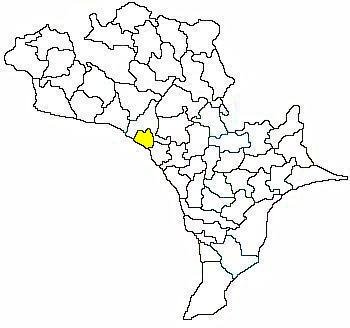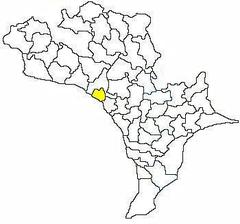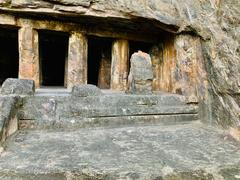
Visiting Buddha Dharma Chakram in Amaravathi: Hours, Tickets, and Tips
Published Date: 25/07/2024
Introduction to Buddha Dharma Chakram
The Buddha Dharma Chakram, also known as the Amaravati Stupa, is an iconic and historically significant monument located in Amaravathi, Andhra Pradesh, India. This ancient site, dating back to the 3rd century BCE, is a testament to India’s rich cultural and religious heritage. Commissioned by Emperor Ashoka of the Maurya Dynasty, the stupa was initially constructed to enshrine the relics of Buddha and propagate the teachings of Buddhism (Wikipedia). Over centuries, it evolved architecturally and artistically, becoming a major center for Buddhist learning and pilgrimage. The site is renowned for its intricate sculptures and carvings, which provide a vivid depiction of various scenes from the life of Buddha. Rediscovered by British archaeologists in the 19th century, the Amaravati Stupa is now protected by the Archaeological Survey of India and continues to attract visitors from around the world (Britannica). Whether you are a history enthusiast, a spiritual seeker, or an avid traveler, the Buddha Dharma Chakram offers a unique and enriching experience.
Overview of Topics Covered
- Introduction
- Ancient Origins and Construction
- Architectural Evolution
- Historical Significance
- Decline and Rediscovery
- Modern Significance
- Special Events and Guided Tours
- Photographic Spots and Travel Tips
- Visitor Information
- FAQ
- Conclusion
Ancient Origins and Construction
The Amaravati Stupa’s origins date back to the 3rd century BCE, during the reign of Emperor Ashoka of the Maurya Dynasty. Ashoka, a devout follower of Buddhism, is believed to have commissioned the construction of the stupa to enshrine the relics of Buddha and to propagate the teachings of Buddhism (Wikipedia). The stupa was constructed in phases, with significant expansions and renovations occurring between the 3rd century BCE and 250 CE. The initial structure was relatively modest, but over time, it was enlarged and adorned with intricate sculptures and carvings that depicted various scenes from the life of Buddha. These artistic embellishments were added during the Satavahana dynasty, which ruled the region between the 3rd and 2nd centuries BCE (Britannica).
Architectural Evolution
The architectural evolution of the Amaravati Stupa can be divided into three distinct phases based on the styles and content of the railing sculptures. The first phase, dating from 50-1 BCE, saw the construction of the initial limestone railing, which was similar in style to the gateways of the Sanchi Stupa I. The second phase, from 50-100 CE, coincided with the construction of other significant Buddhist sites such as the Karli Chaitya and the Pandavleni Caves at Nasik. The third phase, around 200-250 CE, featured more elaborate and sophisticated sculptures, comparable to those found at Nagarjunakonda (Wikipedia). The Amaravati Stupa is renowned for its exquisite sculptures and carvings, which are considered masterpieces of ancient Indian art. The mature Amaravati style is characterized by crowded scenes of graceful, elongated figures that imbue the sculpted scenes with a sense of life and action. The deep cutting of the reliefs allows for overlapping figures on multiple planes, creating a dynamic and three-dimensional effect. The decorative elements reach a level of richness and complexity that is unparalleled in Indian art (Wikipedia).
Historical Significance
The Amaravati Stupa holds immense historical significance as one of the largest and most important Buddhist stupas in India. It served as a major center of Buddhist learning and pilgrimage, attracting students and monks from across India and East and Southeast Asia. The stupa’s prominence continued during the Iksvaku dynasty (3rd to 4th century CE), which succeeded the Satavahanas and continued to support the Buddhist institutions in Amaravati (Britannica). The Chinese traveler and Buddhist monk Xuanzang visited Amaravati in 640 CE and provided a detailed account of the site. He described the stupa as a magnificent structure surrounded by numerous viharas and monasteries. Xuanzang’s writings highlight the significance of Amaravati as a thriving center of Buddhist scholarship and practice during his time (Wikipedia).
Decline and Rediscovery
Following its peak during the Satavahana and Iksvaku periods, the Amaravati Stupa experienced a gradual decline. The site was influenced by various medieval South Indian kingdoms, including the Pallavas, Cholas, and the Vijayanagar Empire. However, with the decline of Buddhism in India, the stupa fell into neglect and was eventually buried under rubble and grass (Wikipedia). In the 19th century, the stupa was rediscovered by British archaeologists, including Colin Mackenzie, who conducted extensive excavations at the site. The surviving sculptures and relics from the stupa were transported to various museums in India and abroad, including the Government Museum in Chennai, the Amaravati Archaeological Museum, and the British Museum in London (Wikipedia).
Modern Significance
Today, the Amaravati Stupa is under the protection of the Archaeological Survey of India, which has undertaken efforts to preserve and restore the site. The stupa remains a popular tourist attraction, drawing visitors from around the world who are interested in its historical and architectural significance. The site also continues to hold spiritual importance for Buddhists, as evidenced by the Kalachakra initiation conducted by the Dalai Lama in 2006, which was attended by over 100,000 pilgrims (Wikipedia). The Amaravati Stupa is not only a testament to the rich cultural and religious heritage of ancient India but also a symbol of the enduring legacy of Buddhism. Its intricate sculptures and carvings provide valuable insights into the artistic and architectural achievements of the time, while its historical significance underscores the importance of Amaravati as a major center of Buddhist learning and pilgrimage.
Special Events and Guided Tours
Throughout the year, the Amaravati Stupa hosts various events and ceremonies that attract visitors from all over. One of the most notable events is the annual Buddha Purnima, which celebrates the birth, enlightenment, and death of Buddha. Guided tours are also available, offering in-depth insights into the history, architecture, and significance of the stupa. These tours are often conducted by knowledgeable local guides or scholars who provide a richer understanding of the site.
Photographic Spots and Travel Tips
The Amaravati Stupa offers numerous photographic opportunities, especially the intricate carvings and sculptures that adorn its structure. Early mornings and late afternoons provide the best natural lighting for photography. Visitors are encouraged to wear comfortable footwear, carry water bottles, and respect the sanctity of the place. The site is wheelchair accessible, making it convenient for all visitors.
Visitor Information
For those planning to visit the Amaravati Stupa, it is located in the Guntur district of Andhra Pradesh, near the village of Amaravathi. The site is accessible from major cities such as Vijayawada, Hyderabad, and Chennai. The best time to visit is between October and March, when the weather is pleasant. The stupa is open to visitors from 8 AM to 6 PM, with an entry fee of INR 20 for Indians and INR 250 for foreigners (Tripoto). Nearby eateries offer a variety of local cuisine, providing an opportunity to experience the flavors of Andhra Pradesh. In addition to the stupa, visitors can explore the adjacent Archaeological Museum, which houses a collection of sculptures and relics from the site. The museum provides a deeper understanding of the history and significance of the Amaravati Stupa, making it a must-visit for history enthusiasts and culture aficionados (Holidify).
FAQ
Q: What are the visiting hours of the Amaravati Stupa?
A: The Amaravati Stupa is open to visitors from 8 AM to 6 PM.
Q: What are the ticket prices for visiting the Amaravati Stupa?
A: The entry fee is INR 20 for Indian citizens and INR 250 for foreigners.
Q: Can I take photographs at the Amaravati Stupa?
A: Yes, visitors are allowed to take photographs. Early mornings and late afternoons offer the best natural lighting for photography.
Q: Is the Amaravati Stupa wheelchair accessible?
A: Yes, the site is wheelchair accessible, making it convenient for all visitors.
Conclusion
Visiting the Amaravati Stupa is a journey through time, offering a unique blend of history, spirituality, and art. Whether you are exploring the intricacies of its sculptures, participating in special events, or simply soaking in the serene atmosphere, the stupa provides an enriching experience for all. For more information on historical sites in Andhra Pradesh and travel tips, follow our blog and stay updated with the latest posts.
Call to Action
Plan your visit to the Amaravati Stupa today and immerse yourself in the rich cultural heritage of ancient India. Download our mobile app for more travel tips and updates, and don’t forget to follow us on social media for the latest news and events.
Summary and Final Thoughts
Visiting the Buddha Dharma Chakram in Amaravathi is not merely a travel experience but a journey through time and spirituality. The site’s rich history, architectural grandeur, and cultural significance make it a must-visit destination for anyone interested in India’s Buddhist heritage. From the ancient carvings that narrate the life of Buddha to the serene ambiance that facilitates spiritual reflection, the Amaravati Stupa offers something for everyone. The modern efforts to preserve and promote this historical monument, including special events and guided tours, ensure that its legacy continues to inspire future generations (Tripoto). Plan your visit between October and March for the most pleasant experience, and don’t miss out on exploring nearby attractions like the Amareshwara Temple and the Amaravati Archaeological Museum. For more information and travel tips, follow our blog and stay updated with the latest posts. Embark on this remarkable journey and immerse yourself in the rich cultural tapestry of ancient India.
Citations and Further Reading
- Amaravati Stupa. (n.d.). In Wikipedia. Retrieved from https://en.wikipedia.org/wiki/Amaravati_Stupa
- Amaravati. (n.d.). In Britannica. Retrieved from https://www.britannica.com/place/Amaravati
- Amaravati Stupa. (n.d.). In Tripoto. Retrieved from https://www.tripoto.com/guntur/places-to-visit/amaravati-stupa
- Amaravati Stupa. (n.d.). In Holidify. Retrieved from https://www.holidify.com/places/guntur/amaravati-stupa-sightseeing-1257711.html

